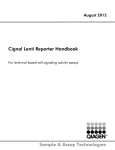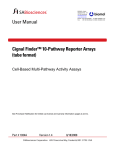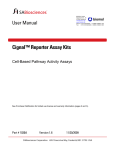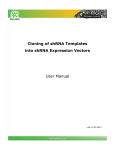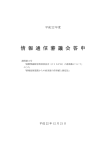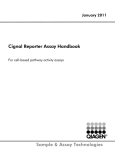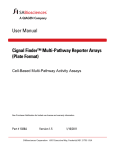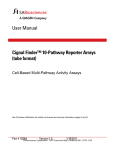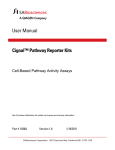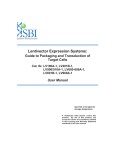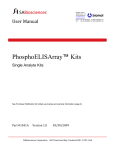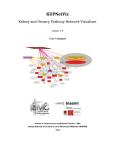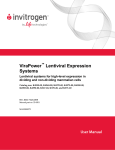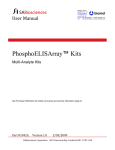Download User Manual - Lucerna
Transcript
User Manual Cignal™ Lenti Reporters Lentiviral Cell Signaling Pathway Reporters See Purchaser Notification for limited use license and warranty information (pages 2 and 3). Part # 1037A Version 1.0 9/5/2008 ™ Cignal Lenti Reporters Lentiviral Cell Signaling Pathway Reporters User Manual (For Catalog Numbers CLS-###L, CLS-###G, and CLA-###L) Ordering and Technical Service Contact Information: • • • • Tel: Fax: On-line Order: E-MAIL: 1-888-503-3187 (US) 301-682-9200 (outside US) 1-888-465-9859 (US) 301-682-7300 (outside US) www.SABiosciences.com [email protected] (to place an order) [email protected] (for technical support) You may place orders by fax, e-mail or from our website. Each order should include the following information: • • • • • Your contact information (name, phone, email address) Product name, catalog number and quantity Purchase order number or credit card information (Visa or MasterCard) Shipping address Billing address For more information, visit us at www.SABiosciences.com LIMITED PRODUCT WARRANTY This product is intended for research purposes only and is not intended for drug or diagnostic purposes or for human use. This warranty limits our liability to replace this product in the event the product fails to perform due to any manufacturing defect. SABiosciences Corporation makes no other warranties of any kind, expressed or implied, including without limitation, warranties of merchantability or fitness for a particular purpose. SABiosciences Corporation shall not be liable for any direct, indirect, consequential or incidental damages arising out of the use, the results of use or the inability to use this product. NOTICE TO PURCHASER I The purchase of Cignal Lenti Reporters includes a limited, nonexclusive license to use the components for research use only. This license does not grant rights to use the components for reproduction of any components, to modify any components for resale or to manufacture commercial products without written approval of SABiosciences Corporation. No other license, expressed, implied or by estoppel, is granted. NOTICE TO PURCHASER II The Dual-Luciferase™ Reporter Assay and Monster Green™ Fluorescent Protein are trademarks of Promega Corporation. NOTICE TO PURCHASER III The purchaser of this product agrees to only use the lentiviral particles in this kit in cell-based reporter assays for in vivo and in vitro internal research. Use of this product for Commercial Purposes requires a license from Sigma-Aldrich Corporation. The purchase of this product conveys to the buyer the nontransferable right to use the purchased amount of the product and components of the product in research conducted by the buyer (whether the buyer is an academic or for-profit entity). The buyer cannot sell or otherwise transfer (a) this product (b) its components or (c) materials made using this product or its components to a third party, or otherwise use this product or its components or materials made using this product or its components for Commercial Purposes. Commercial Purposes means any activity by a party for consideration, but excludes not-for-profit core facilities providing services within their own research institutions at cost. 2 Version 1.0 NOTICE TO PURCHASER III (continued) This product is licensed under U.S. Pat. Nos. 5,817,491; 5,591,624; 5,716,832; 6,312,682; 6,669,936; 6,235,522; 6,924,123 and foreign equivalents from Oxford BioMedica (UK) Ltd., Oxford, UK, and is provided for use in academic and commercial in vitro and in vivo research for elucidating gene function, and for validating potential gene products and pathways for drug discovery and development, but excludes any use of LentiVector® technology for: creating transgenic birds for the purpose of producing useful or valuable proteins in the eggs of such transgenic birds, the delivery of gene therapies, and for commercial production of therapeutic, diagnostic or other commercial products not intended for research use where such products do not consist of or incorporate a lentiviral vector. Information about licenses for commercial uses excluded under this license is available from Oxford BioMedica (UK), Ltd., Medawar Center, Oxford Science Park, Oxford OX4 4GA UK [email protected] or BioMedica Inc., 11622 El Camino Real #100, San Diego CA 92130-2049 USA. LentiVector is a registered US and European Community trademark of Oxford BioMedica plc. SABiosciences Corporation 6951 Executive Way, Suite 100; Frederick, MD 21703; USA Technical Support: [email protected] 3 www.SABiosciences.com CONTENTS I. Introduction 5 II. Product Contents and Descriptions 8 A. Contents 8 B. Description 8 C. Production and Titration of Cignal Lentiviral Particles 10 D. Biosafety Features of Cignal Lentiviral Particles 10 E. Safety Guidelines 10 III. Cignal Lenti Reporter Controls 12 IV. Additional Materials Required 14 V. Protocol 15 A. Before You Begin 15 B. Brief Protocol 17 C. Detailed Protocol 18 VI. Frequently Asked Questions 21 Appendix: Troubleshooting and Cignal Lenti Reporter Products Technical Support: [email protected] 4 23 www.SABiosciences.com Version 1.0 I. Introduction Lentiviral particles have been shown to be the most effective vehicle for transferring and expressing reporter constructs in almost any mammalian cell, including non-dividing cells, primary cells, stem cells, differentiated cells, and difficult-to-transfect cell lines. SABiosciences’ Cignal Lenti Reporters are ready-to-transduce, replication incompetent, HIV-based, VSV-G pseudotyped lentiviral particles. Cignal lentiviral reporter particles are designed for accurate, sensitive and quantitative assessment of the activation of signal transduction pathways. These lentiviral particles express inducible reporter constructs that encode a reporter gene under the control of a basal promoter element (TATA box) joined to tandem repeats of a specific transcriptional response element (TRE). Transcription factor activity can serve as a readout for the intracellular status of many signal transduction pathways. Our constructs are specifically engineered for measuring changes in activity (both increases and decreases) of these signaling pathways. Each of the Cignal Lenti reporters is available with either luciferase or GFP as a reporter gene. The Cignal Lenti reporters are valuable tools for deciphering gene function, as well as determining the mechanism of action of proteins, peptides, ligands, and small molecule compounds in cells that are not amenable to transfection. The Cignal Lenti reporter (luc) encodes for the mammalian codon-optimized, non-secreted form of the firefly luciferase gene, carrying a protein-destabilizing sequence. Cells rapidly degrade the destabilized form of the firefly luciferase protein and hence the background luciferase activity (noise level) is greatly reduced. Due to low background activity, the magnitude of the response that can be measured (signal to noise ratio) as well as the speed of measuring changes in transcription are enhanced. The Cignal Lenti luciferase reporter assays provide outstanding reproducibility, sensitivity, specificity, and signal to noise ratio. They are extremely useful for carrying out endpoint pathway regulation assays. The Cignal Lenti reporter (GFP) enables you to monitor the dynamics of pathway activation on living cells with single cell resolution. The Cignal Lenti reporter (GFP) constructs utilize the Monster Green™ Fluorescent Protein reporter gene. Monster GFP is encoded by an improved synthetic version of the green fluorescent protein gene. This GFP expression cassette has been codon optimized to maximize mammalian cell expression and also utilizes an optimized Kozak sequence to increase translation efficiency. The synthetic GFP is an ideal fluorescent reporter, providing high-level fluorescence and minimal cytotoxicity. Moreover, the synthetic GFP gene is resistant to photobleaching. In addition, most consensus sequences for transcription factor binding have been removed from the synthetic GFP gene in order to minimize aberrant transcription and improve the reliability of the GFP as an accurate reporter. The spectral properties of the Monster Green Fluorescent Protein are slightly red-shifted compared to other commercially available GFP reporters. We recommend using the standard FACS settings of an argon laser (488nm excitation) and filters of 530±15 nm (530 / 30nm) for emission. When analyzing GFP expression via fluorescent microscopy or standard fluorometry, we recommend using an excitation filter of 470±20nm (470 / 40nm) and an emission filter of 515nm (long pass). Technical Support: [email protected] 5 www.SABiosciences.com TM Cignal Lenti Reporters Benefits of Cignal Lenti Reporters • Ready to transduce: Lentiviral vectors arrive as transduction-ready lentiviral particles, eliminating any need to construct and amplify lentivirus in your laboratory • Transduce any cell type: Transduce virtually any cell type, including non-dividing cells, stem cells, and differentiated cells • Wide application: Can be used for transient experiments as well as for developing stable pathway sensor cell lines for a specific cell signaling pathway, using either luciferase or GFP reporter gene technology • Minimal cellular stress: Lentiviral reporter construct delivery method does not produce the non-specific cellular stress responses associated with chemical or electroporation-based transfection methods Technical Support: 888.503.3187 (US) 6 301.682.9200 Version 1.0 Figure 1: Overview of Cignal ™ Lenti Pathway Reporter Applications. The Cignal Lenti Reporters are ready for transduction right out of the box. There is no need to generate or propagate lentivirus in your laboratory. These vectors are extremely useful for transient transduction studies in difficult to transfect cells or for pathway sensor cell line generation. Technical Support: [email protected] 7 www.SABiosciences.com TM Cignal Lenti Reporters II. Product Contents and Descriptions A. Contents Table 1: Cignal Lenti Reporter Product Specifications Component Lenti Reporter – 1 tube Lenti Reporter – 8 tubes Specification Ready-to-transduce transcription factorresponsive lentiviral reporter Ready-to-transduce transcription factorresponsive lentiviral reporter Lentivirus Concentration (total volume) 1X107 TU/ml (250 µl) 1X107 TU/ml (2000 µl) Note: The exact titer of each Cignal Lentivirus preparation is reported on the Certificate of Analysis. Important: We recommend to use Cignal™ Lenti Negative Control and Cignal™ Lenti positive Controlalong with Cignal Lenti Reporter for better interpretation of results (for more details about Cignal Lenti Controls see page 12). B. Description: Cignal Lenti Reporter: The Cignal Lenti Reporters are delivered as ready-to-transduce lentiviral particles expressing an inducible transcription factor-responsive reporter gene (firefly luciferase or GFP) under the control of a basal promoter element (TATA box) joined to tandem repeats of a specific Transcriptional Response Element (TRE). A schematic of the transfer vector used to generate the Cignal Lentiviruses is shown in Figure 2. The Cignal Lenti Reporters monitor both increases and decreases in the activity of a key transcription factor, which is a downstream target of a specific signaling pathway. Technical Support: 888.503.3187 (US) 8 301.682.9200 Version 1.0 Figure 2: Schematic of lentiviral vector used to generate Cignal Lenti Reporters. pCignal Lenti-TRE-Reporter gene encodes the inducible transcription factor-responsive construct expressing firefly luciferase or GFP as a reporter gene. The important features of the vector are described in the table below. Feature RSV-5’ LTR; Hybrid Rous sarcoma Virus (RSV) enhancer/promoter-U5 long terminal repeat Psi; Packaging signal RRE; Rev response element cppt; Central polypurine tract Function Permits viral packaging and reverse transcription of viral mRNA Allow viral packaging Involved in packaging of viral transcript Involved in nuclear translocation and integration of transduced viral genome Allow quantification of transcription Permits high-level expression of the mammalian selection marker (puromycin) Can be used for mammalian selection Modified 3’LTR that allows viral packaging but self inactivates the 5’LTR for biosafety purpose. The element also contains a polyadenylation signal for efficient transcription termination Allows episomal replication of plasmid in eukaryotic cells Allows selection of the plasmid in E.coli Permits regulation of reporter gene expression by a specific transcription factor Act as an minimal promoter Reporter gene (firefly luciferase or GFP) hPGK; human phosphoglycerate kinase eukaryotic promoter PuroR; puromycin resistance gene SIN/3’LTR; 3’ self inactivating long terminal repeat f1 ori; f1 origin of replication AmpR; ampicillin resistance gene TRE; Transcription response element TATA box Technical Support: [email protected] 9 www.SABiosciences.com TM Cignal Lenti Reporters C. Production and Titration of Cignal Lentiviral Particles The infectious, replication-incompetent pseudotyped Cignal Lentiviral particles were produced by cotransfecting specific Cignal Lentivector (Fig. 2) along with plasmids expressing packaging proteins (using VSV-G as an envelope protein) into HEK293T cells. Following cotransfection, we collected the media containing the pseudoviral particles, spin at 1250 rpm for 5 minutes and filtered through 0.45 μm filter. The resultant lentiviruses were aliquoted and stored at -80° C. The lentiviral particles were titered by determining the number of antibiotic resistant cells (colonies) that arise after transduction and puromycin selection of HT-1080 cells. The exact titer of Cignal Lentiviral particles (reporter, negative and positive controls) may vary for different lots and are provided on the certificate of analysis included in each shipment. D. Biosafety Features of Cignal Lentiviral Particles The Cignal Lentiviral particles have numerous biosafety features, which include: • A deletion in the promoter/enhancer region of the U3 portion of 3'LTR ensures selfinactivation of the lentiviral construct after transduction and integration into genomic DNA of target cells. • The Cignal Lentivector and plasmids expressing packaging proteins contain no significant areas of homology and thereby minimizing their chance for recombination. • None of the HIV-1 genes (gag, pol, rev) will be expressed in transduced cells, as they are expressed from packaging plasmids lacking packaging signal. Therefore, the lentiviral particles that are generated are replication-incompetent • No virulence genes (Δvpr, vif, vpu and nef) are present in the Cignal Lentivector so Lentiviral particles will carry only a copy of reporter gene of interest. E. Safety Guidelines Although the Cignal lentiviral particles are replication incompetent, it is highly recommended that they be treated as Risk Group Level 2 (RGL-2) organisms. Follow all published RGL-2 guidelines for handling and waste decontamination. Details on requirements for creating a BSL-2 work environment are available in the U.S. Department of Health and Human Services publication Biosafety in Microbiological & Biomedical Laboratories, 4th edition (http://www.cdc.gov/od/ohs/biosfty/bmbl4/bmbl4toc.htm ). You should also consult the health and safety guidelines and officers at your institution regarding use and handling of the lentiviral system. Technical Support: 888.503.3187 (US) 10 301.682.9200 Version 1.0 While working with Cignal Lenti Reporters, we also recommend following standard safety practices: • Wear double gloves and lab coat at all times. • Perform work in a Class II Biosafety Cabinet (BSC) and post biohazard warning signs. • Minimize splashes or aerosols with careful pipeting. • Autoclave all biological wastes and decontaminate before disposal. Technical Support: [email protected] 11 www.SABiosciences.com TM Cignal Lenti Reporters III. Cignal Lenti Reporter Controls Control Construct Components Concentration And Volume Catalog Number Cignal Lenti Negative Control (LUC) Ready-to-transduce lentivirus expressing noninducible firefly luciferase 1X107TU/ml; 250 µl per tube CLS-NCL Cignal Lenti Positive Control (LUC) Ready-to-transduce lentivirus constitutively expressing firefly luciferase 1X107TU/ml; 250 µl per tube CLS-PCL 1X107TU/ml; 250 µl per tube CLS-RCL 1X107TU/ml; 250 µl per tube CLS-NCG 1X107TU/ml; 250 µl per tube CLS-PCG Cignal Negative Control (GFP) Ready-to-transduce lentivirus constitutively expressing Renilla luciferase Ready-to-transduce lentivirus expressing noninducible Monster GFP Cignal Positive Control (GFP) Ready-to-transduce lentivirus constitutively expressing Monster GFP Cignal Lenti Renilla Control (luc) Description of Cignal Lenti Reporter Controls: 1. Cignal Lenti Negative control: The Cignal Lenti negative controls are ready to transduce lentiviral particles expressing firefly luciferase or Monster GFP under the control of a basal promoter element (TATA box), without any additional transcriptional response elements (Figure 3a). The negative control is critical to establishing the specificity of any treatment effects and determining background reporter activity. 2. Cignal Lenti Positive control: The Cignal Lenti positive controls are ready to transduce lentiviral particles constitutively expressing either firefly luciferase or Monster GFP (Figure 3b), The Cignal Lenti positive control (GFP) is necessary for visual confirmation of transduction. It is also useful for transduction optimization studies. The spectral properties of the Monster Green Fluorescent Protein are slightly red-shifted compared to other commercially available GFP reporters. We recommend using the standard FACS settings of an argon laser (488nm excitation) and filters of 530±15 nm (530 / 30nm) for emission. When analyzing GFP expression via fluorescent microscopy or standard fluorometry, we recommend using an excitation filter of 470±20nm (470 / 40nm) and an emission filter of 515nm (long pass). 3. Cignal Lenti Renilla control (luc): The Cignal Lenti Renilla control is a preparation of ready to transduce lentiviral particles constitutively expressing Renilla luciferase (Figure 3b), The Cignal Lenti Renilla control (luc) serves as an internal control when performing dual-luciferase reporter assays. The Cignal Lenti Renilla control can be helpful in overcoming technical variability and obtain more reliable data. Technical Support: 888.503.3187 (US) 12 301.682.9200 Version 1.0 a. b. Figure 3: Schematic of lentiviral vector used to generate Cignal Lenti Reporter controls. (a) pCignal Lenti-minP-Reporter gene contains a non-inducible firefly luciferase or GFP expression cassette. (b) pCignal Lenti-CMV-Reporter gene contains a constitutive firefly luciferase or GFP or Renilla luciferase expression cassette. The important features of the vectors are the same as those described on page 8 for the pCignal Lenti-TREReporter gene vectors. Technical Support: [email protected] 13 www.SABiosciences.com TM Cignal Lenti Reporters IV. Additional Materials Required: • Mammalian cells cultured in the appropriate growth medium • Cell culture medium and cell culture supplies • Biosafety Level-2 (BSL-2) equipment and work environment • 96-well tissue culture plates • Multi-channel pipettor and pipettor reservoirs • Hemacytometer • Polybrene (Sigma; cat# H9268) • Cignal™ Lenti Negative Control o For firefly luciferase reporter studies: SABiosciences; cat# CLS-NCL o For GFP reporter studies: SABiosciences; cat# CLS-NCG • Cignal™ Lenti Positive Control o For firefly luciferase reporter studies: SABiosciences cat# CLS-PCL o For GFP reporter studies: SABiosciences cat# CLS-PCG • Cignal™ Lenti Renilla Control (For dual-luciferase reporter assay format; SABiosciences cat# CLS-RCL) • Cell culture Growth medium: (DMEM + 10% FBS + 1x NEAA + 1x Pen/Strep) • Puromycin (For generating stable pathway sensor cell lines; Sigma; cat# p8833) • Firefly Luciferase Assay System o Luciferase Assay System (Promega, cat# E1500) o Steady-Glo® Luciferase Assay System (Promega, cat# E2510) o Bright-Glo™ Luciferase Assay System (Promega, cat# E2610) • Dual-Luciferase® Assay System o Dual-Luciferase® Reporter Assay System (Promega, cat# E1910) o Dual-Glo® Luciferase Assay System (Promega, cat# E2920) • 96-well white opaque flat bottom microtiter plate • Luminometer • FACS, flow cytometer, fluorescent microscope, or fluorometer Technical Support: 888.503.3187 (US) 14 301.682.9200 Version 1.0 V. Protocol: A. Before you begin: 1. Cell type selection: The Cignal lentiviral particles are pseudotyped with the VSV-G envelope protein. This allows efficient transduction of lentiviral particles, containing the transcription factor responsive reporter gene (firefly luciferase or GFP), into most mammalian cells. When working with a cell type for the first time, it is recommended to optimize the conditions for efficient transduction. 2. Optimization of conditions for efficient transduction: The sensitivity of the Cignal Lenti Reporter Assay depends on the transduction efficiency. The transduction efficiency, in turn, primarily depends upon the cell type being transduced. Therefore, it is very important to optimize the transduction conditions for each cell type under study. Variables to consider, when optimizing the transduction conditions include Multiplicity of Infection (MOI), concentration of polybrene used, time of assay development and the cell density. The Cignal Lenti positive control (GFP) (SABiosciences; Cat # CLS-PCG) can be used for determining the optimal transduction conditions. Multiplicity of Infection (MOI): The Transduction efficiency of Cignal Lenti reporters varies significantly for different cell type. It is important to determine the Multiplicity of Infection (MOI), which is the number of transducing lentiviral particles per cell, required to get desired transduction efficiency for each new cell type. The MOI is typically adjusted by increasing or decreasing the amount of virus added per well to a series of wells containing the same number of cells. We recommend testing the Cignal Lenti Positive Control (CLSPCG) at an MOI of 5, 10, and 50 (each MOI in triplicate), in order to establish the optimal MOI for each cell type to be studied. To calculate: Multiplicity of Infection (MOI) = Number of transducing units (TU) deposited in a well Number of target cells present in that well. Total transducing units needed per well (TU) = (Total number of cells per well) x (Desired MOI) Total mL of lentiviral particles to add to each well = Total TU needed per well TU/mL reported on Certificate of Analysis We have found that some commonly used cancer cell lines (like HT1080, HEK293 and HepG2 etc.) can be effectively transduced by lentivectors using 10 to 25 MOI, however, some cell types (like primary cells) are more resistant to transduction and efficient transduction of these cell types may require a higher MOI (around 50). Technical Support: [email protected] 15 www.SABiosciences.com TM Cignal Lenti Reporters Importantly, it has been reported in the literature that the VSV-G pseudotyped lentiviruses can be used to transduce stem cells, primary cells (HUVEC, keratinocytes, bone marrow, adipose) and many other cell types, including neurons (DO NOT USE POLYBRENE; it can be toxic to neuronal cells), endothelial, retinal, pancreatic, skin fibroblasts, macrophages, etc. Concentration of polybrene: Polybrene is a small, positively charged molecule that binds to cell surfaces, neutralizes surface charge, increases binding between pseudoviral capsid and the cellular membrane; and greatly enhances transduction efficiency. The optimal concentration of Polybrene depends on cell type and may need to be determined experimentally (usually in the range of 4-8 µg/ml). Polybrene can be toxic to terminally differentiated neurons and dendritic cells. In situations like this, titration of polybrene using 2, 4, 6, 8 ug/ml will have to be done to determine the highest nontoxic concentration that can be used. If toxicity is a big problem, then cells can be transduced in the absence of polybrene but the MOI will have to be increased. Time of assay development: It is recommended to wait a minimum of 48 hours after lentiviral transduction to allow the reporter gene present in the lentiviral vector to reverse transcribe and integrate into the chromosomal DNA. In most cases, expression of reporter gene can be measured 72 hours after transduction (transient transduction). However, some cell types show a delay in expressing reporter genes. In these cases we recommend development of reporter assay at about 96 hours after transduction. Transient transduction or stable cell generation: The Cignal Lenti Reporters work very well for transient transduction experiments. In such transient pathway activation studies, reporter gene expression is typically measured 72 to 96 hours after transduction. At that time, Cignal reporter constructs are integrated into the genomic DNA. These cells can be further cultured under puromycin selection to generate stably transduced signaling pathway sensor cell lines. Some cells lines (like primary cell lines) only express the cignal reporter construct in 10-30% of cells, even when transduced at high MOI’s. For these “difficult-to-transduce” cells, it is important to select the cells stably expressing the reporter gene by puromycin selection for an additional two weeks prior to carrying out pathway activation studies. 3. Optimization of assay condition: The response rate in the Cignal Lenti Reporter Assay depends on the assay conditions (conditions of the experimental treatment). To obtain maximum response given by any stimulus, perform dosing and time-course studies. The optimal amount of stimulus and the time of treatment must be obtained empirically for each experiment (see different protocols for our recommendations). 4. 1. 2. 3. Important recommendations for best results: Perform all transduction in triplicate to minimize variability among treatment groups. Include positive and negative controls in each experiment to obtain reliable results. Take care to always seed the same number of cells in each well, in order to maximize the reproducibility of your experiment. 4. Serum induces various signaling pathways, leading to cross-talk and high background. Therefore, use reduced amounts of serum (0.5%) in the assay medium during the experimental treatment to minimize these serum effects. Technical Support: 888.503.3187 (US) 16 301.682.9200 Version 1.0 B. Brief Protocol: Day 1: Seed cells Day 2: Remove growth medium and add appropriate amount of Cignal Lenti Reporter (typically 10 to 50 MOI)* and polybrene**. Day 3: Remove Cignal Lenti Reporter suspension. Replace with growth medium. Depending upon experimental design, transfect with test siRNA/shRNA plasmids or expression vectors Day 4 or 5: Depending upon experimental design, treat with test proteins, peptides, or compounds Day 5 or 6: Analyze pathway reporter gene expression (luciferase or GFP) * We recommend using the Cignal Lenti Positive Control (cat. no. CLS-PCG) in an initial experiment, to determine the optimal MOI for the target cells being studied. * Polybrene enhances lentiviral transduction efficiency in most cell types. Technical Support: [email protected] 17 www.SABiosciences.com TM Cignal Lenti Reporters C. Detailed Protocol The following protocol is designed to transduce HEK293 cells using Cignal Lenti Reporters in a 96-well plate format. The Cignal Lenti Reporters work well with other mammalian cells. If you are using plates or wells of different size, adjust the components in proportion to the surface area. This is just a general guideline; the optimal transduction conditions should be optimized according to the cell type and the study requirements. Read the protocol completely before starting the experiment. Day 1 1. Trypsinize 90% confluent HEK293 cells with trypsin-EDTA for 2-5 minutes at 37 ºC to make cell suspension. Gently detach the cells from tissue culture dish with a pipette, mix with one volume of culture medium containing 10% fetal bovine serum, then centrifuged down, remove the supernatant, and suspend cells to 0.5-1 x 105 cells/ml in growth media. To ensure reproducible transfection results, it is important to determine the cell density with a hemacytometer. 2. Add 100 μl of resuspended cells (0.5-1X104 cells) in each well of 96-well plate. Triplicate wells for each lentiviral reporter, negative control and positive control should be used. 3. Incubate cells at 37°C overnight in a humidified 5% CO2 incubator. Note: While determining the plating density, please consider that the growth rates of cells vary greatly and account for the length of time the cells will be growing before the assay development. Day 2 4. Remove medium from wells. To each well add 20 µl of Cignal lentiviral particles (Lenti reporter or Lenti negative control or Lenti positive control) and make up the total volume of 50 µl using growth medium with antibiotics (DMEM with 10% FBS, 0.1mM NEAA, 1mM Sodium pyruvate). In this particular case, add 30 µl of growth medium with antibiotics. 5. Add Polybrene to a final concentration of 8 µg/ml in each well. Gently swirl the plate to mix. 6. Incubate 18-20 hours at 37°C in a humidified incubator in an atmosphere of 5% CO2. Note: Polybrene enhances transduction of most cell types, however, some cells like primary neurons are sensitive to Polybrene. Do not add Polybrene to these types of cells. If working with a cell type for the first time, a Polybrene control only well should be used to determine cell sensitivity. Important: When transducing Cignal lentiviral particles into a cell type for the first time, we Technical Support: 888.503.3187 (US) 301.682.9200 18 Version 1.0 suggest using either 10 or 50 MOI as a starting point to determine the optimal assay development conditions. Always include Cignal Lenti positive control (GFP) for determining transduction efficiency. Day 3 7. Remove the medium containing Cignal lentiviral particles from wells. Add 100 µl of fresh growth medium (DMEM with 10% FBS, 0.1mM NEAA, 1mM Sodium pyruvate, 100 U/ml penicillin and 100 µg/ml streptomycin) to each well. Day 5 8. Harvest the transduced cells and assay for the expression of the reporter gene. Important notes: 1. In most cell types the expression of reporter gene can be measured directly at about 72 hours after transduction (day 5 of the assay). However, some cell types show a delay in expressing reporter genes and in these cases we recommend development of reporter assay at about 96 hours after transduction (day 6 of the assay). 2. The luciferase assay can be developed by using either the Firefly Luciferase or DualLuciferase Reporter Assay Systems from Promega. Follow the manufacturer’s protocol for developing the assay. 3. The expression of the Monster GFP reporter can be monitored via FACS, flow cytometry, fluorescent microscopy, or standard fluorometry. The spectral properties of the Monster Green Fluorescent Protein are slightly red-shifted compared to other commercially available GFP reporters. We recommend using the standard FACS settings of an argon laser (488nm excitation) and filters of 530±15 nm (530 / 30nm) for emission. When analyzing GFP expression via fluorescent microscopy or standard fluorometry, we recommend using an excitation filter of 470±20nm (470 / 40nm) and an emission filter of 515nm (long pass). 4. To determine the effect of siRNA/shRNA on a specific reporter or signaling pathway, we recommend doing transient transfection of siRNA/shRNA on day 3 of the assay. 5. To determine the effect of overexpression of a gene on a specific reporter or signaling pathway, we recommend doing the transient transfection of 100-200 ng of experimental vector and negative control vector 24 or 36 hours before the assay development. 6. To determine the effect of recombinant protein or small peptide on a specific reporter or signaling pathway, we recommend changing the cell medium to assay medium (Opti-MEM® containing 0.5% of fetal bovine serum, 1% NEAA, 100 U/ml Penicillin and 100 µg/ml Streptomycin) and treating the transduced cells with 3 to 4 Technical Support: [email protected] 19 www.SABiosciences.com TM Cignal Lenti Reporters different concentration of recombinant protein or small peptide about 6 or 24 hours before the assay development. 7. To determine the effect of small chemicals on a specific reporter or signaling pathway, we recommend changing the cell medium to assay medium (Opti-MEM® containing 0.5% of fetal bovine serum, 1% NEAA, 100 U/ml Penicillin and 100 µg/ml Streptomycin) and treating the transduced cells with 3 to 4 different concentration of small chemicals about 6 or 24 hours before the assay development. 8. For the generation of stable cell line, on DAY 4 remove the growth medium and replace it with fresh growth medium that contains the appropriate amount of puromycin for selection of transduced cells. Replace medium with fresh, puromycin-containing medium every 3-4 days until resistant colonies can be identified (after selection). Pick a minimum of 5 puromycin-resistant colonies and expand each clone. Check each clone for its ability to sense the modulation of the activity of the specific transcription factor or signaling pathway. Use the most responsive clone for further studies. 9. To determine the appropriate amount of puromycin for selection of transduced target cells, perform the puromycin titration (kill curve) using the following guidelines: i. Plate 1.6 x 104 cells into wells of a 96-well plate with 120 µl fresh media. ii. The next day add 500–10,000 ng/ml of puromycin to selected wells. iii. Examine viability every 2 days. iv. Culture for 10–14 days. Replace the media containing puromycin every 3 days. v. The minimum concentration of puromycin that causes complete cell death after 3–5 days should be used for that cell type. Technical Support: 888.503.3187 (US) 20 301.682.9200 Version 1.0 VI. Frequently Asked Questions: Q: How many cells can I transduce with the amount of Cignal Lenti Reporter provided by SABiosciences? A: The amount of cells that can be transduced depends upon your chosen target cells and how easily they are transduced. Primary or other difficult cells may require higher MOI's than cell lines. It is recommended to perform a limiting dilution titer on your target cells utilizing our Cignal Lenti positive control (cat# CLS-PCG) to determine the optimal amount of viral particles needed for your particular cell type. Q: How can I make sure that my cell type of interest can be transduced with Cignal Lentiviruses? A: The Cignal Lentiviruses are pseudotyped with VSV-G Protein, which is pantropic and allows the lenitivirus to interact with its target cell in a receptor-independent manner. This receptor-independent entry into the target cell likely involves endocytosis. Thereby, in theory, the lentivirus can transduce virtually any mammalian cell type. Also, lentivirus does not require a mitotic event for integration into the host cell genome. However, it is recommended to consult the literature or utilize our Cignal Lenti positive control (cat# CLSPCG) to determine if your target cells of interest can be transduced with Cignal Lentiviruses. Q: Can Cignal Lentivirus particles be further propagated in the lab? A: No, Cignal Lentivectors are engineered for maximum biosafety, and are therefore replication incompetent. Genes for replication are not included in the packaged viral genome, and the lentiviral vector contains a self-inactivating 3'LTR. Q: Does the Cignal lentivirus produce any toxic viral genes? A: The Cignal Lentiviruses do not carry or express any viral genes and therefore have no associated toxicity issues. Q: How labile is the Cignal lentivirus? A: The lentivirus is sensitive to temperature (65°C or higher), hypo-osmolarity, 10% bleach, 70% ethanol, and detergents (Triton X-100, etc.). Q: How one can decontaminate lentiviral contaminated surfaces? A: Please follow CDC guidelines. We typically use 10% bleach to inactivate the virus. Q: What does transduction unit (TU) mean? Technical Support: [email protected] 21 www.SABiosciences.com TM Cignal Lenti Reporters A: Transducing Units refer to the number of vector genomes that can infect, enter and integrate into a population of cells. Q: What precautions one should take while handling Cignal Lentiviruses? A: The Cignal Lentiviruses should be used in a BSL2 tissue culture cabinet using gloves and BSL2 tissue culture procedures. For any other troubleshooting or technical questions about the Cignal Lenti Reporters, please call one of our Technical Support representatives at 1-888-5033187 or 301-682-9200 or email at [email protected]. Technical Support: 888.503.3187 (US) 22 301.682.9200 Version 1.0 Appendix: Troubleshooting and Cignal Lenti Reporter Products A. Reasons for inefficient transduction or low expression of Cignal Lenti Reporters Target cell type may be difficult to transduce: Optimize the transduction protocol (number of cell, polybrene concentration and MOI required for best transduction) and use higher MOI. In some cases, polybrene is toxic for target cells. Volume of Cignal lentiviral particles used is too high: Keep the volume as low as possible to achieve maximal adsorption of viral particles to the cells. The assay is performed too early: Usually the maximal expression of integrated transgene is expected to develop by 72 hours after infection, however, some cells showed delayed expression. Therefore, we suggest developing the assay at a later time, such as 96 hours. Inactivation of Cignal Lentiviral particles during storage: Store lentiviruses at –80°C. and avoid freeze-thaw cycle. Cignal Lentiviral stock medium affects target cell growth: Dilute the stock medium or concentrate the pseudovirus by centrifugation to minimize the amount of stock medium added to the target cells. B. Reasons for no expression from Cignal Lenti positive control It might be any one of the reasons stated above OR CMV promoter is not functional in target cells: In certain cell types the CMV promoter is not functional. In these cases, one has to change the type of target cells or replace use lentivirus having constitutive active promoter other than the CMV promoter. Technical Support: [email protected] 23 www.SABiosciences.com TM Cignal Lenti Reporters Cignal Lenti Reporters Pathway C/EBP cAMP/PKA Cell Cycle DNA Damage Hypoxia Type I Interferon Interferon Gamma MAPK/ERK MAPK/JNK c-Myc NFκB Notch PKC/Ca++ Retinoic Acid Receptor TGFβ Wnt Transcriptional Regulatory Element (TRE) C/EBP binding element cAMP regulatory element (CRE) E2F binding element p53 response element HIF response element Interferon stimulated response element (ISRE) Interferon gamma activation sequence (GAS) Serum response element (SRE) AP1- binding element E-box binding element NFκB binding element RBP-Jκ binding element NFAT response element Retinoic acid response element (RARE) SMAD response element TCF/LEF response element Technical Support: MGFP Cat. No. C/EBP Dual luciferase Cat. No. CLS-001L CREB CLS-002L CLS-002G E2F/DP1 p53 Hypoxia-inducible factor-1 (HIF-1) STAT1/STAT2 CLS-003L CLS-004L CLS-007L STAT1/STAT1 CLS-009L Elk-1/SRF CLS-010L CLS-010G AP-1 Myc/Max NFκB RBP-Jκ CLS-011L CLS-012L CLS-013L CLS-014L CLS-011G NFAT CLS-015L Retinoic Acid Receptor (RAR) CLS-016L SMAD2/SMAD3/SMAD4 CLS-017L TCF/LEF CLS-018L Transcription Factor 888.503.3187 (US) 24 CLS-008L 301.682.9200 CLS-013G CLS-014G CLS-018G Version 1.0 Cignal Lenti Reporter Controls Control Construct Components Concentration And Volume Catalog Number Cignal Lenti Negative Control (LUC) Ready-to-transduce lentivirus expressing noninducible firefly luciferase 1X107TU/ml; 250 µl ---1 tube CLS-NCL Cignal Lenti Positive Control (LUC) Ready-to-transduce lentivirus constitutively expressing firefly luciferase 1X107TU/ml; 250 µl per tube CLS-PCL 1X107TU/ml; 250 µl per tube CLS-RCL 1X107TU/ml; 250 µl per tube CLS-NCG 1X107TU/ml; 250 µl per tube CLS-PCG Cignal Negative Control (GFP) Ready-to-transduce lentivirus constitutively expressing Renilla luciferase Ready-to-transduce lentivirus expressing noninducible Monster GFP Cignal Positive Control (GFP) Ready-to-transduce lentivirus constitutively expressing Monster GFP Cignal Lenti Renilla Control (luc) Cignal Finder Lenti 10-Pathway Reporter Arrays Product Name Components Concentration and Volume Cignal Finder Lenti Cancer 10-Pathway Reporter Array Ready-to-transduce transcription factor-responsive lentiviral firefly luciferase pathway reporters (10 tubes total) + negative and positive controls (1 tube each) 1X107TU/ml; 250 µl of each reporter and control CLA-001L Cignal Finder Lenti Immune Response 10-Pathway Reporter Array Ready-to-transduce transcription factor-responsive lentiviral firefly luciferase pathway reporters (10 tubes total) + negative and positive controls (1 tube each) 1X107TU/ml; 250 µl of each reporter and control CLA-002L Cignal Finder Lenti Development 10-Pathway Reporter Array Ready-to-transduce transcription factor-responsive lentiviral firefly luciferase pathway reporters (10 tubes total) + negative and positive controls (1 tube each) 1X107TU/ml; 250 µl of each reporter and control CLA-003L Cignal Finder Lenti Toxicity 10-Pathway Reporter Array Ready-to-transduce transcription factor-responsive lentiviral firefly luciferase pathway reporters (10 tubes total) + negative and positive controls (1 tube each) 1X107TU/ml; 250 µl of each reporter and control CLA-004L Technical Support: [email protected] 25 Catalog Number www.SABiosciences.com Notes: Technical Support: [email protected] 26 www.SABiosciences.com Version 1.0 Notes: Technical Support: [email protected] 27 www.SABiosciences.com Cignal™ Lenti Reporters Part #1037A Version 1.0 9/5/2008





























